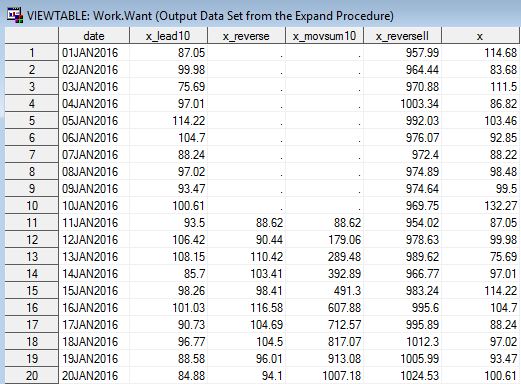- Home
- /
- Analytics
- /
- Forecasting
- /
- Proc Expand - Convert statement
- RSS Feed
- Mark Topic as New
- Mark Topic as Read
- Float this Topic for Current User
- Bookmark
- Subscribe
- Mute
- Printer Friendly Page
- Mark as New
- Bookmark
- Subscribe
- Mute
- RSS Feed
- Permalink
- Report Inappropriate Content
I'm trying to understand how PROC EXPAND works and why one calculation isn't working the way I expect.
I don't understand why the third one doesn't work the way as expected.
The first two calculations are correct, but LEAD doesn't generate the data expected.
From this original discussion:
http://stackoverflow.com/q/42395126/1919583
*create sample data to work with;
data random;
call streaminit(25);
do date='01Jan2016'd to '31Dec2016'd;
x=round(Rand('normal', 100, 15), 0.01);
output;
format date date9.;
end;
run;
*Modified calculation;
proc expand data=random out=want;
id date;
convert x= x_movSum /transformout = (movsum 10 trimleft 9); /*This is the correct calculation expected*/
convert x = x_movSumFIRST / transformout = (reverse movsum 10 trimleft 9 reverse);
convert x = x_movSumWRONG /transformout = (lead 10 reverse movesum 10 reverse); /*suggest via Tom*/
run;
Accepted Solutions
- Mark as New
- Bookmark
- Subscribe
- Mute
- RSS Feed
- Permalink
- Report Inappropriate Content
Hello -
If I understand your question correctly you are mostly wondering about the effect of "lead 10", correct?
proc expand data=random out=want;
id date;
convert x = x_movSumWRONG /transformout = (lead 10 reverse movesum 10 reverse); /*suggest via Tom*/
run;
Your data (random) looks like this - leaving out some data in the middle:
| date | x |
| 1-Jan-16 | 114.68 |
| 2-Jan-16 | 83.68 |
| 3-Jan-16 | 111.5 |
| 4-Jan-16 | 86.82 |
| 5-Jan-16 | 103.46 |
| 6-Jan-16 | 92.85 |
| 7-Jan-16 | 88.22 |
| 8-Jan-16 | 98.48 |
| 9-Jan-16 | 99.5 |
| 10-Jan-16 | 132.27 |
| 11-Jan-16 | 87.05 |
| 12-Jan-16 | 99.98 |
| 13-Jan-16 | 75.69 |
| … | … |
| 20-Dec-16 | 93.67 |
| 21-Dec-16 | 114.5 |
| 22-Dec-16 | 94.1 |
| 23-Dec-16 | 96.01 |
| 24-Dec-16 | 104.5 |
| 25-Dec-16 | 104.69 |
| 26-Dec-16 | 116.58 |
| 27-Dec-16 | 98.41 |
| 28-Dec-16 | 103.41 |
| 29-Dec-16 | 110.42 |
| 30-Dec-16 | 90.44 |
| 31-Dec-16 | 88.62 |
- Lead 10 will tell EXPAND to forget about the first 10 observations (obs) - so your time series now starts at 87.05 - you will introduce missing values are the end of your series (unless you would add SETMISS 0, which would append 0s instead).
- Reverse will tell EXPAND to reverse the order, the missing values you introduced will be your new first obs, 87.05 your new last obs.
- Movesum 10 will create the backward moving sum of 10 obs.
- Finally Reserve will put the series into its original order again.
If you decompose your "wrong" statement into:
proc expand data=random out=want;
id date;
convert x = x_lead10 /transformout = (lead 10);
convert x = x_reverse /transformout = (lead 10 reverse);
convert x = x_movsum10 /transformout = (lead 10 reverse movsum 10);
convert x = x_reverseII /transformout = (lead 10 reverse movsum 10 reverse);
run;
you will see these columns in WANT.
In my mind this is the expected behaviour - it is just not the same what you'd like to archive with:
convert x= x_movSum /transformout = (movsum 10 trimleft 9);
Hope this makes sense,
Udo
- Mark as New
- Bookmark
- Subscribe
- Mute
- RSS Feed
- Permalink
- Report Inappropriate Content
Hello -
If I understand your question correctly you are mostly wondering about the effect of "lead 10", correct?
proc expand data=random out=want;
id date;
convert x = x_movSumWRONG /transformout = (lead 10 reverse movesum 10 reverse); /*suggest via Tom*/
run;
Your data (random) looks like this - leaving out some data in the middle:
| date | x |
| 1-Jan-16 | 114.68 |
| 2-Jan-16 | 83.68 |
| 3-Jan-16 | 111.5 |
| 4-Jan-16 | 86.82 |
| 5-Jan-16 | 103.46 |
| 6-Jan-16 | 92.85 |
| 7-Jan-16 | 88.22 |
| 8-Jan-16 | 98.48 |
| 9-Jan-16 | 99.5 |
| 10-Jan-16 | 132.27 |
| 11-Jan-16 | 87.05 |
| 12-Jan-16 | 99.98 |
| 13-Jan-16 | 75.69 |
| … | … |
| 20-Dec-16 | 93.67 |
| 21-Dec-16 | 114.5 |
| 22-Dec-16 | 94.1 |
| 23-Dec-16 | 96.01 |
| 24-Dec-16 | 104.5 |
| 25-Dec-16 | 104.69 |
| 26-Dec-16 | 116.58 |
| 27-Dec-16 | 98.41 |
| 28-Dec-16 | 103.41 |
| 29-Dec-16 | 110.42 |
| 30-Dec-16 | 90.44 |
| 31-Dec-16 | 88.62 |
- Lead 10 will tell EXPAND to forget about the first 10 observations (obs) - so your time series now starts at 87.05 - you will introduce missing values are the end of your series (unless you would add SETMISS 0, which would append 0s instead).
- Reverse will tell EXPAND to reverse the order, the missing values you introduced will be your new first obs, 87.05 your new last obs.
- Movesum 10 will create the backward moving sum of 10 obs.
- Finally Reserve will put the series into its original order again.
If you decompose your "wrong" statement into:
proc expand data=random out=want;
id date;
convert x = x_lead10 /transformout = (lead 10);
convert x = x_reverse /transformout = (lead 10 reverse);
convert x = x_movsum10 /transformout = (lead 10 reverse movsum 10);
convert x = x_reverseII /transformout = (lead 10 reverse movsum 10 reverse);
run;
you will see these columns in WANT.
In my mind this is the expected behaviour - it is just not the same what you'd like to archive with:
convert x= x_movSum /transformout = (movsum 10 trimleft 9);
Hope this makes sense,
Udo
- Mark as New
- Bookmark
- Subscribe
- Mute
- RSS Feed
- Permalink
- Report Inappropriate Content
Makes sense, thanks Udo 🙂
April 27 – 30 | Gaylord Texan | Grapevine, Texas
Registration is open
Walk in ready to learn. Walk out ready to deliver. This is the data and AI conference you can't afford to miss.
Register now and lock in 2025 pricing—just $495!
- Marketing Minutes | Insights in 20: Streamlining Your Data Into One Consistent View | 14-Jan-2026
- Ask the Expert: Real-Time Agent Assist and Next-Gen Strategy for Financial Services | 15-Jan-2026
- Discovery-based Investigation in SAS Visual Investigator – Your Guide to Better Searches | 20-Jan-2026
- Ask the Expert: The AI Advantage: How SAS Customer Intelligence 360 Solves Real Marketing Challenges | 27-Jan-2026
- DCSUG presents SAS OnDemand for Academics: the Easy Way to Learn SAS For Free for Students, Educator | 27-Jan-2026
- SAS Innovate 2026 | Grapevine, Texas | 27-Apr-2026


